Armstrong's Alpine NJ tower rescues NYC TV after 9/11
MAY 22, 2014 BY TVNEWSCHECK
The
National September 11 Memorial Museum opened this week on the old World
Trade Center site in New York City. Part of the emotional museum
exhibit is the demolished television broadcast antenna mast that was
used to transmit many of New York City’s broadcast signals before the
terrorist attack.

A new antenna mast atop One World Trade Center is now trying to recruit
broadcast clients who are willing to move their antennas back to the
World Trade Center site. Only time will tell if that effort is
successful.
This week — with photos of the tower wreckage dominating the news —
it’s a good time to recall some amazing World Trade Center antenna
history that connects back to the earliest days of broadcasting in the
late 1930s.
The story begins with FM radio and its inventor, Edwin Howard
Armstrong. His legacy in New York City came full circle on Sept 11,
2001, the day the World Trade Center collapsed. It was the moment that
a new generation of broadcasters realized that a tower that Armstrong
had built in 1937 could save over-the-air television transmission in
the shaken city.
When the massive antenna mast atop the north tower of the trade center
crumbled into rubble, the signals of most major New York City
broadcasters went off-the-air. Unable to quickly relocate to the
crowded spar at the peak of the Empire State Building, the broadcasters
turned to what has become a broadcast landmark—Armstrong’s tower on the
Palisades Interstate Parkway in Alpine, New Jersey.
 Among the stations installing antennas on the Alpine tower in the wake
of the disaster were WNBC, Ch. 4; WABC, Ch.7, WPIX, Ch. 11 and WNET,
Ch. 13. However, in the scurry to get back on the air, few realized the
irony of choosing Armstrong’s historic mast, once the site of America’s
first FM radio station.
Among the stations installing antennas on the Alpine tower in the wake
of the disaster were WNBC, Ch. 4; WABC, Ch.7, WPIX, Ch. 11 and WNET,
Ch. 13. However, in the scurry to get back on the air, few realized the
irony of choosing Armstrong’s historic mast, once the site of America’s
first FM radio station.
“The idea of NBC ending up there….it’s kind of ironic, isn’t it? Maybe
Armstrong is turning over in his grave,” mused Jerry Minter in an
interview I did with him in 2001. Minter, who died at age 95 in 2009,
was a veteran radio engineer who knew Armstrong personally.
The incongruity stems from a series of events beginning in the 1930s
that helped define American broadcasting. The 102-story Empire State
Building, opened in 1931, was at the time the tallest building in the
world and a natural place to install broadcast antennas. Its 1,250-foot
peak, originally designed as a mooring for dirigibles, was soon
converted to an antenna mast.
Early on, the Empire State Building’s 85th floor became a hotbed of
broadcast activity. It was home to RCA’s experimental television
station, which began broadcasting shortly after the skyscraper opened.
Eventually, “Empire” became home to nearly all of New York City’s
television stations, remaining so until completion of the 110-story
World Trade Center in the early 1970s.
Empire’s 85th floor was also home to Edwin Armstrong’s FM radio
laboratory. By 1935, it was clear that Armstrong’s “static-less” FM
system worked well. Perhaps too well. RCA chief David Sarnoff,
claiming he needed the space for television, ordered Armstrong — who
wanted to begin an FM broadcasting service in the city — to remove his
equipment and vacate the Empire State Building.
“Sarnoff was very much worried that since one FM station could pick up
another that they would be relaying (programming) instead of using the
telephone lines in the NBC network,” recalled Renville McMann, who
began his engineering career with Armstrong at age 14. “More than being
threatening to AM radio, FM was threatening to the networks which at
the time were largely under the control of RCA and NBC.”
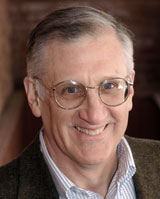 Armstrong’s eviction from Empire left the inventor undeterred in his
quest to bring high fidelity FM radio to New Yorkers. After purchasing
11-acres in Alpine, N.J. that overlooked the New York metropolitan
landscape, Armstrong built a 425-foot, three-armed steel tower in 1937
and soon launched the nation’s first FM radio station.
Armstrong’s eviction from Empire left the inventor undeterred in his
quest to bring high fidelity FM radio to New Yorkers. After purchasing
11-acres in Alpine, N.J. that overlooked the New York metropolitan
landscape, Armstrong built a 425-foot, three-armed steel tower in 1937
and soon launched the nation’s first FM radio station.
Tom Lewis
It was a spectacular project, both in its visionary foresight and
scenic beauty. “The view from that magnificent tower is unbelievable.
You can see out to the tip of Long Island. It’s a great piece of
technological real estate,” said Tom Lewis, author of Empire of the
Air: The Men Who Made Radio, a 1991 history of radio broadcasting.
 Armstrong’s independent FM radio venture, however, would lead to a
legendary feud with rival Sarnoff. After World War II, with the launch
of commercial television on the horizon, a lengthy patent battle ensued
between Armstrong and Sarnoff’s RCA and NBC network. It would
eventually consume Armstrong.
Armstrong’s independent FM radio venture, however, would lead to a
legendary feud with rival Sarnoff. After World War II, with the launch
of commercial television on the horizon, a lengthy patent battle ensued
between Armstrong and Sarnoff’s RCA and NBC network. It would
eventually consume Armstrong.
David Sarnoff
“Sarnoff started stealing the patents. In early television equipment,
RCA paid a royalty for the picture component, but they decided not to
pay a royalty on the audio component, which was the invention of
Armstrong,” said Lewis. “What Sarnoff did to Armstrong was just awful.
Just inhuman.”
Along with Lee de Forest, Armstrong is recognized as one of radio’s
great pioneers. Among his contributions are the invention of the
regenerative circuit (1912); the superheterodyne circuit (1918); the
superregenerative circuit (1920); and the wideband frequency modulation
system that became known as FM radio.
Armstrong’s wideband FM system offered improved noise properties and
delivered significantly better performance under adverse weather
conditions, noted McMann. RCA promoted an alternative design, but the
engineering community was in wide agreement that it violated
Armstrong’s patents.
“Sarnoff was trying to block FM and trying to block Armstrong. Making
him go broke was as good a way as any other,” said McMann. “RCA
effectively chose to violate his patents and not pay him.”
In 1954, Armstrong, financially devastated and under family pressure to
end his long legal fight with Sarnoff, dressed in a suit and overcoat
with scarf and gloves and jumped to his death from his New York City
apartment. “I would give my life to turn back to the time when we were
so happy and free,” Armstrong wrote in a suicide note to his wife.
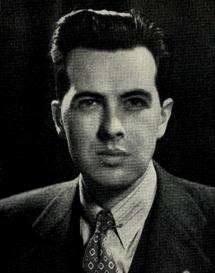 Armstrong’s widow, once Sarnoff’s personal secretary, continued her
husband’s legal proceedings over the patents. Eventually, the courts
validated Armstrong’s position, establishing him — not RCA and NBC — as
the legitimate inventor of key FM radio technology and the sound system
used by analog television.
Armstrong’s widow, once Sarnoff’s personal secretary, continued her
husband’s legal proceedings over the patents. Eventually, the courts
validated Armstrong’s position, establishing him — not RCA and NBC — as
the legitimate inventor of key FM radio technology and the sound system
used by analog television.
Jerry Minter, 1948
Jerry Minter remembered Armstrong’s funeral. “Sarnoff sat behind me.
I’d never met him, but he shook hands with me and everybody there. When
it was over, he just stood there looking stunned as we all walked off.
He was very upset. I think he felt responsible.”
When Armstrong designed his Alpine tower, he anticipated using it one
day for television, recalled Minter. “But because of the feud between
Armstrong and Sarnoff, it didn’t come off. Now, we are reliving that
history.”
- - - - - - - - part 2 - - - - - - - -
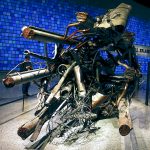
As
the National September 11 Memorial Museum in New York City opened this
week to the public, visitors are encountering the remains of the World
Trade Center’s broadcast antenna mast destroyed by terrorists in 2001.
Here is part two of the story of how that demolished antenna brought
New York City broadcasting to its knees and knocked most stations off
the air.
As Edwin Armstrong’s associates contemplated the historical
implications brought on by the World Trade Center disaster in 2001,
their memories raced back to happier times at Alpine — especially those
of Armstrong’s daring penchant for climbing the great steel structure.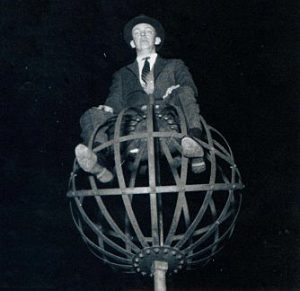
“He was utterly fearless on the tower,” remembered Renville McMann, who
began his engineering career with Armstrong at age 14. “He used to
climb the tower for exercise. But when it came time to come down, he
would step into a bucket attached to a cable controlled by an electric
winch and have himself lowered to the ground. He recognized that winch
was very dangerous, but did it anyway. Ten thousand dollars wouldn’t
have gotten me in that bucket. I was leaving my fingerprints in the
steel.”
In 2001, the tower was and is still owned by Charles Sackerman and
operated by the Alpine Tower Company of Woodcliff Lake, NJ. Before the
disaster, it was home to a variety of communications services for
government and industry and to WFDU, a radio station operated by
Fairleigh Dickinson University in Teaneck, NJ.
After the World Trade Center attack, Alpine began hosting television
transmitters for the first time in its history. The situation was only
temporary, however.
Over time, most of the broadcasters eventually moved their main
transmission antennas to either the Empire State Building or 4 Times
Square. Whether they move to the new antenna mast at One World Trade
Center is still unknown, pending the outcome of FCC’s spectrum auctions.
The Armstrong Tower, however, still services many broadcasters, mainly
today with auxiliary antennas. Yet, it’s history is written. The tower
saved New York City television broadcasting in a time of emergency and
continues to have value more than 75 years after its construction.
“The site has ideal topography for VHF and UHF transmission. It’s high,
doesn’t have close structures and there are no reflections. It has
everything you’d like to have for a transmitter shack,” said John
Turner, president of Turner Engineering Associates of Mountain Lakes,
NJ, in an interview in 2001.
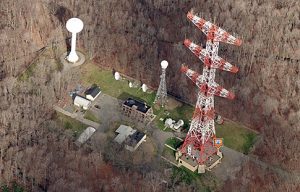 “The
top of the tower is roughly the height of the Empire State Building. It
favors the northern counties. People in New Jersey and Long Island
won’t see much difference. They may even get better pictures.”
“The
top of the tower is roughly the height of the Empire State Building. It
favors the northern counties. People in New Jersey and Long Island
won’t see much difference. They may even get better pictures.”
“WNBC’s move to the Alpine tower completes a full circle in broadcast
history,” said Tom Lewis, author of Empire of the Air: The Men Who Made
Radio, a 1991 history of radio broadcasting. “It’s a great irony that
this magnificent tower that Armstrong built in 1937 is now saving the
bacon of NBC and other New York broadcasters in 2001.”
McMann agreed. “Armstrong was technically brilliant. Many of his ideas
were truly great. He came up with solutions that others of us would not
have considered. He was head and shoulders above any other engineer
I’ve ever known. I don’t think Sarnoff knew how to turn on and off the
lights. He’d been a telegraph operator, but he was no engineer.”
For supporters of Edwin Armstrong, a man who died thinking he was a
failure, the events of September, 2001 were another validation of his
genius. “Not only the building of that tower, but every time you touch
a television or radio you touch an invention of Edwin Howard
Armstrong,” said Lewis in an interview after the attack.
“I bet you can find few people at NBC today who even know who Armstrong
was. But the ultimate irony is they wouldn’t be getting a paycheck
today had it not been for him.”


 Among the stations installing antennas on the Alpine tower in the wake
of the disaster were WNBC, Ch. 4; WABC, Ch.7, WPIX, Ch. 11 and WNET,
Ch. 13. However, in the scurry to get back on the air, few realized the
irony of choosing Armstrong’s historic mast, once the site of America’s
first FM radio station.
Among the stations installing antennas on the Alpine tower in the wake
of the disaster were WNBC, Ch. 4; WABC, Ch.7, WPIX, Ch. 11 and WNET,
Ch. 13. However, in the scurry to get back on the air, few realized the
irony of choosing Armstrong’s historic mast, once the site of America’s
first FM radio station. Armstrong’s eviction from Empire left the inventor undeterred in his
quest to bring high fidelity FM radio to New Yorkers. After purchasing
11-acres in Alpine, N.J. that overlooked the New York metropolitan
landscape, Armstrong built a 425-foot, three-armed steel tower in 1937
and soon launched the nation’s first FM radio station.
Armstrong’s eviction from Empire left the inventor undeterred in his
quest to bring high fidelity FM radio to New Yorkers. After purchasing
11-acres in Alpine, N.J. that overlooked the New York metropolitan
landscape, Armstrong built a 425-foot, three-armed steel tower in 1937
and soon launched the nation’s first FM radio station. Armstrong’s independent FM radio venture, however, would lead to a
legendary feud with rival Sarnoff. After World War II, with the launch
of commercial television on the horizon, a lengthy patent battle ensued
between Armstrong and Sarnoff’s RCA and NBC network. It would
eventually consume Armstrong.
Armstrong’s independent FM radio venture, however, would lead to a
legendary feud with rival Sarnoff. After World War II, with the launch
of commercial television on the horizon, a lengthy patent battle ensued
between Armstrong and Sarnoff’s RCA and NBC network. It would
eventually consume Armstrong. Armstrong’s widow, once Sarnoff’s personal secretary, continued her
husband’s legal proceedings over the patents. Eventually, the courts
validated Armstrong’s position, establishing him — not RCA and NBC — as
the legitimate inventor of key FM radio technology and the sound system
used by analog television.
Armstrong’s widow, once Sarnoff’s personal secretary, continued her
husband’s legal proceedings over the patents. Eventually, the courts
validated Armstrong’s position, establishing him — not RCA and NBC — as
the legitimate inventor of key FM radio technology and the sound system
used by analog television.


 “The
top of the tower is roughly the height of the Empire State Building. It
favors the northern counties. People in New Jersey and Long Island
won’t see much difference. They may even get better pictures.”
“The
top of the tower is roughly the height of the Empire State Building. It
favors the northern counties. People in New Jersey and Long Island
won’t see much difference. They may even get better pictures.”